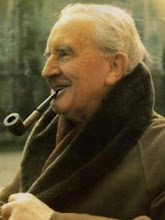
The above painting is by the Tolkien artist John Howe. In many ways, I prefer his work to that of Ted Nasmith, although I don't think I can explain why adequately - I can put it no better than ''I know what I hate.'' Anyway, it depicts the Doors of Night, the ''dragon-headed door'' or the ''gateway of the moon'' as it is called in ancient tales, set against the Wall of Things - imagine the airs, the three airs, coming to a sudden end, the fence or wall of the world, a vast dome, within which there is a portal into the Void. The Doors of Night are one of the oldest things in Tolkien, going back even to before the Lost Tales. The Lost Tales themselves tell us somewhat of their origin:
''Thus came it that the Gods dared a very great deed, the most mighty of all their works; for making a fleet of magic rafts and boats with Ulmo's aid - and otherwise had none of these endured to sail upon the waters of Vai - they drew to the Wall of Things, and there they made the Door of Night (Moritarnon or Tarn Fui as the Eldar name it in their tongues). There it still stands, utterly black and huge against the deep-blue walls. Its pillars are of the mightiest basalt and its lintel likewise, but great dragons of black stone are carved thereon, and shadowy smoke pours slowly from their jaws. Gates it has unbreakable, and none know how they were made or set, for the Eldar were not suffered to be in that dread building, and it is the last secret of the Gods; and not the onset of the world will force that door, which opens to a mystic word alone. That word Urwendi only knows and Manwë who spake it to her; for beyond the Door of Night is the outer dark, and he who passes therethrough may escape the world and death and hear things not yet for the ears of Earth-dwellers, and this may not be.'' (The Book of Lost Tales, Volume I, Chapter IX, The Hiding of Valinor).
The above quotation is not ''canonical.'' The tales comprising the early History of Middle-earth were revised extensively over the years into what is now the published Silmarillion, and so there is no reason to go by what this says to the letter. The names Vai, Moritarnon, Tarn Fui and Urwendi are of course obsolete. I sometimes prefer the old tales, if just because they are more ''unknowable'' or rudimentary or mysterious. The question is this: when exactly were they wrought by the Valar? No definitive answer is given in the canonical Legendarium; indeed, there is no entry for ''Door of Night'' given in the Index of The Silmarillion, and it only crops up once in the tale - right at the end. They are certainly not mentioned in the Appendices of The Lord of the Rings.
One theory concerning their origin goes that they were created at the dawn of the first light of the Sun and Moon, as a sort of ''portal'' into the Outer Void, where the Sun and Moon would go out and return. Another is that they were created at the end of the First Age of the Sun as a portal to cast out Morgoth. Which is more in fitting with the rest of the tale I wonder? My supposition is that the former is more likely; if only because the latter seems to suggest too great a creative labour for the Valar so late into the history of Arda, and it seems nicer. Although I have often wondered about the presence of ''dragons'' - creatures of Morgoth, even if they are lifeless. Smoke is said to constantly issue from their jaws. Perhaps they are like gargoyles? Morgoth, in the Outer Void, is impotent and perhaps blind, until towards the end of the history of Arda he regains somewhat of his former might and closes in about Arda as a great shadow - so maybe the Dragons were set there to guard against his return, a way rather after the manner of Cathedral gargoyles of cheating the Devil into thinking that the Kingdom of Arda is a place already evil with the purpose of driving him off. Who knows?
I dreamt of it once, when I was staying with my grandmother; I stood on the edge of a vast precipice and beheld the world mapped out below, romantically as an unbroken ''forest kingdom'' and beheld the sky, from which there seemed to be suspended a kind of candelabra or chandelier, great candles perched upon vast tree branches, with leaves of the most divers and sweetest green, and at the four corners of the earth there were four pillars around which there were steep stairs. I longed to fly like a bird to that place. It was eerily beautiful. That's when I woke up and I remember no more...

No comments:
Post a Comment